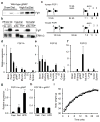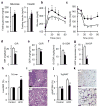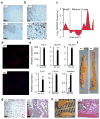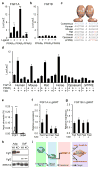A PPARγ-FGF1 axis is required for adaptive adipose remodelling and metabolic homeostasis
- PMID: 22522926
- PMCID: PMC3358516
- DOI: 10.1038/nature10998
A PPARγ-FGF1 axis is required for adaptive adipose remodelling and metabolic homeostasis
Abstract
Although feast and famine cycles illustrate that remodelling of adipose tissue in response to fluctuations in nutrient availability is essential for maintaining metabolic homeostasis, the underlying mechanisms remain poorly understood. Here we identify fibroblast growth factor 1 (FGF1) as a critical transducer in this process in mice, and link its regulation to the nuclear receptor PPARγ (peroxisome proliferator activated receptor γ), which is the adipocyte master regulator and the target of the thiazolidinedione class of insulin sensitizing drugs. FGF1 is the prototype of the 22-member FGF family of proteins and has been implicated in a range of physiological processes, including development, wound healing and cardiovascular changes. Surprisingly, FGF1 knockout mice display no significant phenotype under standard laboratory conditions. We show that FGF1 is highly induced in adipose tissue in response to a high-fat diet and that mice lacking FGF1 develop an aggressive diabetic phenotype coupled to aberrant adipose expansion when challenged with a high-fat diet. Further analysis of adipose depots in FGF1-deficient mice revealed multiple histopathologies in the vasculature network, an accentuated inflammatory response, aberrant adipocyte size distribution and ectopic expression of pancreatic lipases. On withdrawal of the high-fat diet, this inflamed adipose tissue fails to properly resolve, resulting in extensive fat necrosis. In terms of mechanisms, we show that adipose induction of FGF1 in the fed state is regulated by PPARγ acting through an evolutionarily conserved promoter proximal PPAR response element within the FGF1 gene. The discovery of a phenotype for the FGF1 knockout mouse establishes the PPARγ–FGF1 axis as critical for maintaining metabolic homeostasis and insulin sensitization.
Conflict of interest statement
The authors declare no competing financial interests.
Figures




References
-
- Forman BM, et al. 15-Deoxy-Δ12,14-Prostaglandin J2 is a ligand for the adipocyte determination factor PPARγ. Cell. 1995;83:803–812. - PubMed
-
- Barak Y, et al. PPAR gamma is required for placental, cardiac, and adipose tissue development. Mol Cell. 1999;4:585–595. - PubMed
-
- Tontonoz P, Spiegelman BM. Fat and beyond: the diverse biology of PPARgamma. Annu Rev Biochem. 2008;77:289–312. - PubMed
Publication types
MeSH terms
Substances
Associated data
- Actions
Grants and funding
- R01 HL105278/HL/NHLBI NIH HHS/United States
- DK062434/DK/NIDDK NIH HHS/United States
- U19 DK062434/DK/NIDDK NIH HHS/United States
- P30 DK063491/DK/NIDDK NIH HHS/United States
- HHMI/Howard Hughes Medical Institute/United States
- R37 DK057978/DK/NIDDK NIH HHS/United States
- DK063491/DK/NIDDK NIH HHS/United States
- HL105278/HL/NHLBI NIH HHS/United States
- P50 HD012303/HD/NICHD NIH HHS/United States
- R37 DK033651/DK/NIDDK NIH HHS/United States
- DK057978/DK/NIDDK NIH HHS/United States
- R24 DK090962/DK/NIDDK NIH HHS/United States
- R01 DK033651/DK/NIDDK NIH HHS/United States
- DK090962/DK/NIDDK NIH HHS/United States
- R01 DK057978/DK/NIDDK NIH HHS/United States
- P30 CA014195/CA/NCI NIH HHS/United States
LinkOut - more resources
Full Text Sources
Other Literature Sources
Molecular Biology Databases

